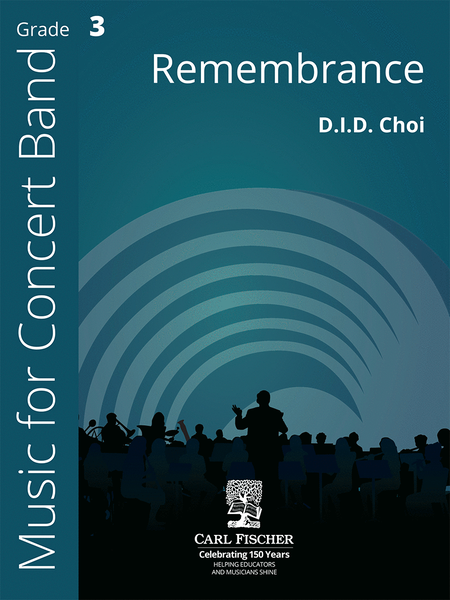Details
Description
SKU: CF.CPS265F
Composed by Dong-In Choi. Full score. 20 pages. Duration 5 minutes. Carl Fischer Music #CPS265F. Published by Carl Fischer Music (CF.CPS265F).ISBN 9781491161753. UPC: 680160920440.
Remembrance was written in November 2018. "In remembrance of what it took for us to be here..." was the only original program note. The piece can mean different things to different people; however, it brings unity to all under the theme of remembrance. We fight for many things: love, patriotism, freedom, ideology, possession...all of which have cost tremendous sacrifice. It was the battles, the blood and sweat, and the sacrifice of those that came before us that created the world as we know it. Remembrance is a tender, melancholic reflection that silently gives thanks to every step and every sacrifice that was made to bring us what we have today. Yes, what we have may not be perfect--nor is it anywhere near complete--but with each generation's responsibility to "carry the torch" and never forget, hopefully we can make everything worth it. Performance Notes This tender piece is an excellent opportunity to explore nuanced phrasing. While many sections may play similar parts, often the phrasing and dynamics are marked differently across the band. Each of these discrepancies should be brought out and add to the perpetual motion of the piece. Encourage confident, yet subtle entrances and furthermore, think about the ends of notes as important as the beginning. Really bring out the hairpins in sections such as m. 29, m. 67, and m. 81 as expressive devices. Despite the piece's major key, through the various levels of dissonance and tension, both the ensemble and the audience should feel the sacrifices and tragedy that this piece celebrates. The tempo should not be much slower than the marked tempos and with the careful observation of the various tempo changes, there should be a constant momentum pushing throughout the piece, all the way past the end that leaves the audience in thought with an uplifting, pensive, and gentle clarinet chord.
Remembrance was written in November 2018. “In remembrance of what it took for us to be here...” was the only original program note. The piece can mean different things to different people; however, it brings unity to all under the theme of remembrance.We fight for many things: love, patriotism, freedom, ideology, possession...all of which have cost tremendous sacrifice. It was the battles, the blood and sweat, and the sacrifice of those that came before us that created the world as we know it. Remembrance is a tender, melancholic reflection that silently gives thanks to every step and every sacrifice that was made to bring us what we have today. Yes, what we have may not be perfect—nor is it anywhere near complete—but with each generation’s responsibility to "carry the torch" and never forget, hopefully we can make everything worth it.Performance NotesThis tender piece is an excellent opportunity to explore nuanced phrasing. While many sections may play similar parts, often the phrasing and dynamics are marked differently across the band. Each of these discrepancies should be brought out and add to the perpetual motion of the piece. Encourage confident, yet subtle entrances and furthermore, think about the ends of notes as important as the beginning. Really bring out the hairpins in sections such as m. 29, m. 67, and m. 81 as expressive devices. Despite the piece’s major key, through the various levels of dissonance and tension, both the ensemble and the audience should feel the sacrifices and tragedy that this piece celebrates.The tempo should not be much slower than the marked tempos and with the careful observation of the various tempo changes, there should be a constant momentum pushing throughout the piece, all the way past the end that leaves the audience in thought with an uplifting, pensive, and gentle clarinet chord.

 Share
Share